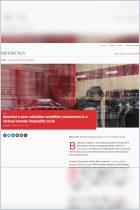Join getAbstract to access the summary!

Join getAbstract to access the summary!
Christine L. Dobridge
For Better and for Worse?
Effects of Access to High-Cost Consumer Credit
Federal Reserve Board, 2016
What's inside?
US states have passed various laws to tackle payday lending, but such loans could be beneficial.
Recommendation
Debt is an important aspect of American life, but economic theory diverges on the consequences of credit access to human well-being. Economist Christine Dobridge specifically looks at the impact of payday loans – small, short-term, high-interest loans – on US households in this brief but informative study. Should these loans, which some critics consider predatory lending, face stringent regulation or prohibition? Or do they actually serve a useful purpose that justifies allowing people access to them? getAbstract recommends this astute report to policy makers and financial services professionals for its insights into the payday lending market.
Summary
About the Author
Christine L. Dobridge is an economist with the Federal Reserve System.




















Comment on this summary